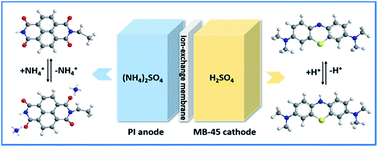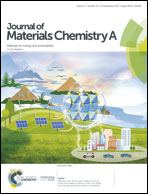Metal-free energy storage systems: combining batteries with capacitors based on a methylene blue functionalized graphene cathode†
Abstract
Beyond conventional hybrid ion capacitors (HICs) based on porous carbon capacitive materials, the introduction of faradaic pseudocapacitance in HICs is an effective method to enhance energy density. Herein, we prepare methylene blue functionalized graphene (MB-X) composites taking advantage of electrostatic and extensive π-conjugated interaction. The test results confirm that the composites have high rate capability and excellent cycle stability on account of the synergistic effect between graphene and MB molecules. In order to improve the safety of HICs, an aqueous electrolyte is a promising candidate as long as the cell voltage can be efficiently increased. Therefore, we skillfully employ aqueous solutions with different pH values as asymmetric electrolytes to assemble HICs, where polyimide acts as the battery material and MB-X serves as the capacitive material. Thanks to the asymmetric electrolytes, the constructed aqueous HICs can operate at a cell voltage of 1.9 V, much larger than the decomposition voltage of water. Moreover, the flexible structure, and reversible and fast redox reactions of both the anode and cathode make the aqueous HICs display a maximum energy density of 48.6 W h kg−1 and a maximum power density of 19 kW kg−1, as well as a long-cycle lifetime with a decay of 0.00172% per cycle.

- This article is part of the themed collection: 2019 Journal of Materials Chemistry A Most Popular Articles


 Please wait while we load your content...
Please wait while we load your content...